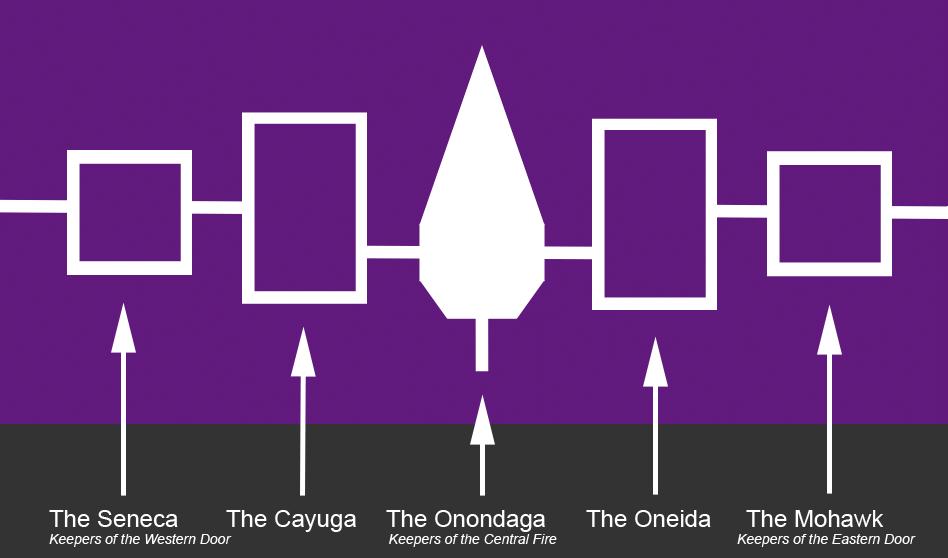
3 minute read
HAUDENOSAUNEE
Called the Iroquois Confederacy by the French, and the League of Five Nations by the English, the confederacy is properly called the Haudenosaunee Confederacy meaning People of the long house. The confederacy was founded by the prophet known as the Peacemaker with the help of Aionwatha, more commonly known as Hiawatha. The exact date of the joining of the nations is unknown and said to be time immemorial making it one of the first and longest lasting participatory democracies in the world.
The confederacy, made up of the Mohawks, Oneidas, Onondagas, Cayugas, and Senecas was intended to unite the nations and create a peaceful means of decision making. To learn more, click here.
Advertisement
Figure 3 Haudenosaunee flag
The Haudenosaunee have 13 ceremonies throughout the year representing the 13 moons throughout the year. These ceremonies occur at various times of the year often following seasonal changes. Most ceremonies are a way of expressing thanks to the people, the natural world, the spirit world, and the creator. It is hoped that this will help to maintain the health and prosperity of the nations To learn more, click here
When nations within the Haudenosaunee Confederacy have meetings or ceremonies, or anything of importance they begin and end with what is called the Thanksgiving Address or opening acknowledgment. In the Mohawk language it is called the Ohenten Kariwatekwen translating to mean “words before all else.” This opening gives thanks to all of creation starting with us, or the people, and continuing upwards from the earth to the waters, the trees, the birds, the thunders, etc., and ultimately the creator. The world is an orderly place, and every part has been given responsibilities and instructions. Each continues to fulfill its duties as well as it can. This gratitude reminds us that humans are no more important than other living parts of the world. ISA is currently working on a proposal to implement this into commencement.
Contributions
The resource in this toolkit is by no means a comprehensive look at Native Americans impacts on U.S. society and culture; however, these resources provide examples that American Spaces can use to foster discussion about Native Americans meaningful contributions.
The Native Americans are not just the original inhabitants of the North American continent; they have also contributed immensely to the country that is now the United States of America. These tribes learned how to make the best of the land; tame the wild beasts, raised animals, domesticated the plants, and created several medicines. To learn more, click here
For examples see below:
• Politics and Government – The Haudenosaunee Confederacy influenced the United States Constitution; to learn more, click here.
• Sports – Lacrosse, America's oldest te am sport, dates to 1100 A.D., when it was played by the Haudenosaunee; to learn more, click here .
HOW MANY INDIGENOUS PEOPLE ARE THERE AND WHERE DO THEY LIVE?
Quantifying the number of members belonging to indigenous communities and their exact locations is a complicated task. Statistics coincide, however, to indicate that there are around 370 million indigenous people in the world, spread throughout more than 5,000 groups. These peoples live in over 90 countries on five continents, with Asia (headed by China) the region with the most indigenous people in the world and Europe with the fewest:
• America 39,750,000
• Europe 250,000
• Africa 50,000,000
• Asia 273,000,000
• Oceania 7,000,000
To learn more, visit click here.
WORDS MATTER: IT’S IMPORTANT TO USE LANGUAGE CORRECTLY
Alaska Native This term refers to the indigenous people of the area. Native Alaskan is anyone from Alaska (including non-indigenous).
American Indian Some tribes (and their associated parks) prefer Native American. Use specific tribal name(s) whenever possible, accurate, and appropriate. See also First Nations, tribal names.
First Nation, First Nations
Refers to aboriginal people in Canada who are neither Inuit (people of the Canadian Arctic) nor Métis (descendants of First Nation people who married Europeans). Often used in the plural in the collective sense, as in a program for First Nations youth. The term is widely used in Canada but is not used in the US, except in connection with Métis whose homelands include northwest Minnesota, North Dakota, or other northern states. See also American Indian.
Native American Use if requested by specific tribes or parks. See American Indian.
Tribal name Use specific tribal name(s) whenever possible, accurate, and appropriate. Also, the preference is to use the singular noun: Navajo, Lakota, Tlingit. See also American Indian. Examples: The Navajo entered Canyon de Chelly about 300 years ago. The Anishinaabek fished in Lake Superior.



